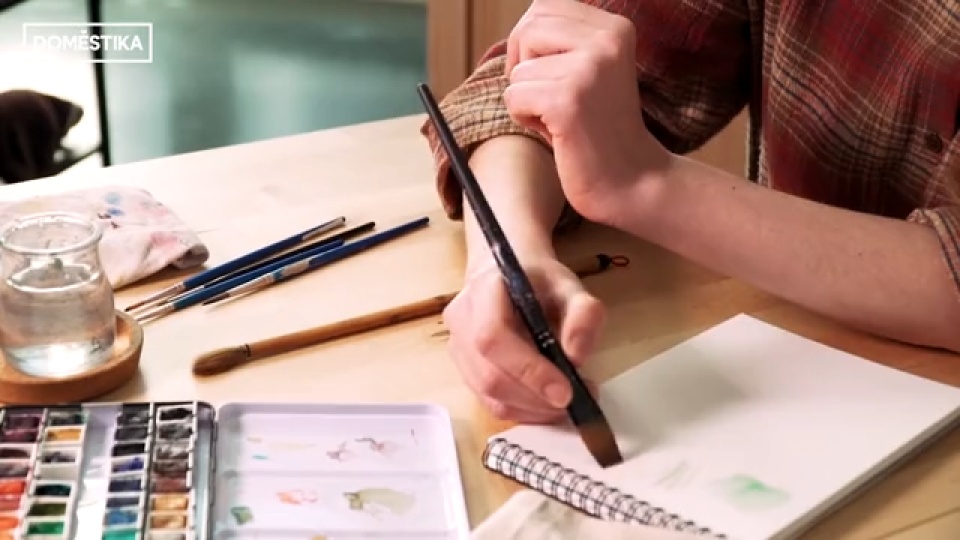Watercolor Tutorial: How to Paint with Watercolor Brushes and Pencils

Naranjalidad teaches us different techniques to mix colors with brushes or watercolor pencils, step by step
Watercolor offers a wide array of creative possibilities. You only need a brush and a few pigments to get going. Choosing the right colors, brushes and techniques is crucial for bringing the final work to life.
Naranjalidad (@naranjalidad) is the artist name of Spanish illustrator and architect Beatriz Ramo. In this article, she tells us concisely how to use two different tools to apply watercolor–pencils and brushes–and how to mix them to create a universe as colorful as hers.

How to paint with a watercolor pencil
Watercolor pencils are like normal colored pencils but, by diluting them with water, they offer a huge range of possibilities similar to other types of watercolor.
Naranjalidad’s first piece of advice is that painting with these pencils consists of making a color guide as colors behave differently when they’re dry or wet. You can make the guide by wetting the color and painting on paper, indicating to the side which number color each mark corresponds with.


What techniques can we use to paint with watercolor pencils?
Here are different ways to use colored pencils: apply before wetting, mix tones, take the pigment from the pencil, and wet the tip.
1. Apply before wetting
This consists of applying the color directly to the paper and then passing a wet pencil over it until the color becomes an even patch of color.
You can use more or less water according to how much you want the traces of the original pencil markings to stand out or blend into the water.


2. Mix tones
This technique is ideal to obtain a tone that mixes two colors. First a layer of one is applied, then the other on top and, with a wet brush, it is moistened until an even mixture is left.


This technique is useful to create more intense touches of color.
Use a wet brush to take the color directly from the tip of the wet pencil and apply it directly to the paper.

4. Wet the tip
With this method, you can wet the end of the pencil directly and make the pencil strokes stand out as the tip softens. This way, the pencil is slightly wet and the texture is similar to that of a pastel color.


How to mix colors with watercolors
Naranjalidad shares their three favorite techniques for mixing watercolors and shows us how they look on paper: mix on the palette, mix on paper, and juxtapose your layers.
1. Mix watercolor on a palette
This is the simplest way to mix watercolor and it consists of mixing directly on the palette. This way you create a more homogenous mix and a more uniform tone.
The first step is choosing a color and applying the right amount of water according to the surface you wish to cover, applying it to the palette, cleaning the brush and eliminating any excess water. Then you can choose your second colour and mix the two well until the pigments are balanced. Now, you can apply it to your paper.


Factors to bear in mind in this process according to your color palette:
· Metal or ceramic palettes: these are Naranjalidad’s personal choice as the color is distributed better and it is easier to control the final mix that you’re working on.
· Plastic palettes: with this type of palette, the water will accumulate because of the surface tension which makes it difficult to see the color you’re mixing clearly.
2. Mix watercolor on paper
This technique is used when trying to find less homogenous results. The colors are mixed directly on the paper and some of the different shades which make up the final color will remain visible.
The first step is to create a layer of color on the paper and while it is still wet–without forgetting to clean the brush–you then choose the other color you want to mix on the paper.

3. Overlaying colors on paper
The result with this technique is totally different to the ones before: you will clearly see the different layers of color, one on top of the other. With this tool, instead of mixing colors you place them on top of each other.
First, you choose your color for the first layer and wait for it to dry. Then, you add the next color on top. The amount of paint you use will depend on the color you want to achieve. This style takes advantage of the watery quality of watercolors to create a new color while the original colors are still visible.
Learn this and more of Naranjalidad’s tricks in their course, Portrait with Pencil, Colour Techniques and Photoshop.
You may also be interested in these tutorials:
- Embroidery Tutorial: Herringbone Stitch
- Craft Tutorial: How to Prepare Your Frame to Start Embroidering
- Illustration Tutorial: The Color Wheel






0 comments